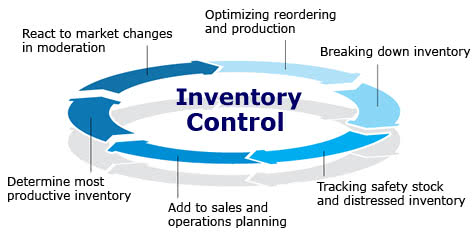Inventory Management
7 Ways to Improve Inventory Control

The most challenging aspect of inventory management is maintaining proper inventory control. Every business has had to deal with shortages, overages, excess inventory, and bottle-necks in the shipping and distribution process, so knowing how best to manage these issues is key to successful inventory control. The top recommendations that we found around the web included:
- Identify shortages ahead of time
- Track distressed inventory properly
- Forecast inventory needs to avoid excess inventory
- Don’t overreact to changes in the market
Of course, that’s not all there is to proper inventory control, so we took a look across the web to find resources and tips from inventory management experts in order to find the most widely held best practices for improving inventory control.

1) Knowing Your Inventory
It’s not enough to just be aware of what’s in your inventory; you also have to break it down into its component parts so that it’s easier to keep track of certain categories of inventory. Breaking down your operating inventory into safety, replenishment, and excess or obsolete stock is the first step in maintaining proper inventory control.
Recommended Resources:
How to Establish a Practical Inventory Management System
- –
Tips on building an inventory control system that works for you (via BizFilings)
2) Daily Checks on Safety Stock Levels
Another important task that’s often overlooked is checking safety stock levels. If you take a look at it on a daily basis and at a more granular level, then it goes a long way towards ensuring that your inventory data is as up to date as possible. It might seem tedious and something that can be tracked via automation, but keeping close tabs on safety stock makes a difference.
Recommended Resources:
Inventory Accuracy Improves Performance on Logistics Metrics
- –
How accuracy in your operating inventory can improve inventory control (via IndustryWeek)
3) What’s Your Most Productive Inventory?
Many businesses just try to keep a level inventory on all of their products, whether it’s high or low selling inventory. However, it’s important to determine what your most productive inventory is and focus on that, rather than just trying to have the same amount of product across the board. It doesn’t make sense to keep levels of inventory on product that doesn’t sell frequently, and you definitely don’t want to run out of stock on product that does sell quickly, so focus purchasing on that.
Recommended Resources:
10 ways to improve inventory management
- –
Tips on how to categorize your inventory better (via Bain & Company)
4) Maintaining Proper Inventory Levels
You should be keeping pretty reliable data on inventory levels throughout the year, which means that you should be able to project what those levels will be in the coming months. Determine the optimal frequency for reordering and/or producing inventory, and you’ll have a much easier time controlling inventory levels.
Recommended Resources:
How Retail can Increase Their Sales Through Inventory Control
- –
More tips for managing inventory (via About.com)
5) Tracking Distressed Inventory
It’s easy to let things fall between the cracks, but keeping proper tabs on distressed inventory is probably the biggest problem that most businesses and warehouses have. Sometimes you get overstocked, product doesn’t sell fast enough, and soon you have piles of distressed inventory to deal with. By keeping track of how long you’ve had certain inventory, you can move it out before it reaches the point of no return and you can’t sell it anymore. If you can’t sell it, donate it if you can, and then you’ll at least be able to write it off on your business’s tax return.
Recommended Resources:
ERP for Inventory Control (Infographic)
- –
(via Visua.ly)
6) Add Inventory Control to Sales and Operations Planning
You’d think that companies would already do this, but a surprising number keep inventory management separate from their sales and operations plannings. By integrating the two together, you maintain a better overall view of business operations, which in turn gives you better control over your inventory. For information on integrating inventory management with sales and operations planning, see the resource below.
Recommended Resources:
Five Strategies for Improving Inventory Management Across Complex Supply Chain Networks
- –
This report goes into greater detail on integrating inventory management into S&OP on page 15 (via CSCO Insights and Cognizant)
7) Don’t Let the Market Sway You Too Much
Many businesses often get caught up in new trends and buy up a lot of new inventory in order to try out new products to sell. Often, though, it won’t pay off, and you’ll end up with an overstock of items that you can’t get rid of. Instead of letting apparent market trends control you, seriously consider whether you’re making good choices for your business. It may be tempting to buy (or not buy) inventory because of the way the market looks, but if you’ve been following the rest of the steps above, then you won’t have to react excessively to shifts in buyer trends.
Recommended Resources:
Control Inventory before It Controls You
- –
Tips on using information on changes in the market to managing your inventory (via Accounting Web)
For more information be sure to check out our collection of blog content on Top Inventory Management Software.





